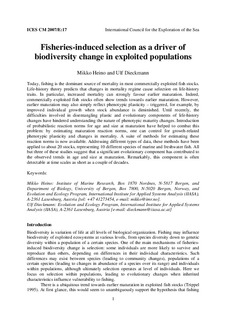| dc.contributor.author | Heino, Mikko | |
| dc.date.accessioned | 2012-02-07T08:42:14Z | |
| dc.date.available | 2012-02-07T08:42:14Z | |
| dc.date.issued | 2007 | |
| dc.identifier.citation | This report is not to be quoted without prior consultation with the General Secretary. | no_NO |
| dc.identifier.uri | http://hdl.handle.net/11250/103168 | |
| dc.description.abstract | Today, fishing is the dominant source of mortality in most commercially exploited fish stocks.
Life-history theory predicts that changes in mortality regime cause selection on life-history
traits. In particular, increased mortality can strongly favour earlier maturation. Indeed,
commercially exploited fish stocks often show trends towards earlier maturation. However,
earlier maturation may also simply reflect phenotypic plasticity – triggered, for example, by
improved individual growth when stock abundance is diminished. Until recently, the
difficulties involved in disentangling plastic and evolutionary components of life-history
changes have hindered understanding the nature of phenotypic maturity changes. Introduction
of probabilistic reaction norms for age and size at maturation have helped to combat this
problem: by estimating maturation reaction norms, one can control for growth-related
phenotypic plasticity and changes in mortality. A suite of methods for estimating these
reaction norms is now available. Addressing different types of data, these methods have been
applied to about 20 stocks, representing 10 different species of marine and freshwater fish. All
but three of these studies suggest that a significant evolutionary component has contributed to
the observed trends in age and size at maturation. Remarkably, this component is often
detectable at time scales as short as a couple of decades. | no_NO |
| dc.language.iso | eng | no_NO |
| dc.publisher | ICES | no_NO |
| dc.relation.ispartofseries | ICES CM documents;2007/E:17 | |
| dc.subject | biodiversity | no_NO |
| dc.subject | biologisk mangfold | no_NO |
| dc.subject | fish stocks | no_NO |
| dc.subject | fiskebestander | no_NO |
| dc.subject | exploitation | no_NO |
| dc.subject | beskatning | no_NO |
| dc.title | Fisheries-induced selection as a driver of biodiversity change in exploited populations | no_NO |
| dc.type | Working paper | no_NO |
| dc.subject.nsi | VDP::Agriculture and fishery disciplines: 900::Fisheries science: 920::Resource biology: 921 | no_NO |
| dc.subject.nsi | VDP::Mathematics and natural science: 400::Zoology and botany: 480::Marine biology: 497 | no_NO |
| dc.source.pagenumber | 5 s. | no_NO |
